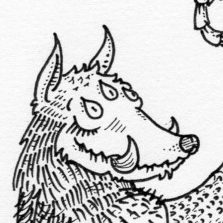
× × ×
Colorful cries! — Loud banners!
Lords command and soldiers manuever
The whole world is upset –
the death of a City is the birth of regret
Then, softly, the twinkling bells of peace returning.
× × ×
Greed begot Conflict
A storm of steel & fire
WAR AND VIOLENCE are never considered or accepted as a means to gain control over land or people. But they are never far behind when money is involved: trade & capital is where the specter of brutality found the cracks through which it slipped into Bos.
The Arys-Haltte dispute
THE CLASH for Kýsteen-Oonde was the final confrontation in a conflict between the trade league of Haltte* and the Dukes of Arys†. It was the decisive battle to the longest-running military campaign in recorded history.
THE ORIGINS of this monstrous war are rooted in greed; after years of financial subterfuge the trade guild of Haltte managed to cut the city of Arys from a historical trade route, in order to drastically lower taxes on import products from Vrankke. (a region of which Arys is a gateway city) The Dukes of Arys, not wanting to lose their main source of income, assembled their bannermen, distributed the pikes, and called for military action against the Haltte league.
BOTH SIDES gathered numerous smaller factions behind them, in an attempt to outnumber the opposition. All picked a side for much the same reasons; fresh jealousy, old rivalries, pride and the promise of glory… Both blocks set out on a campaign that would result in clashes & skirmishes over the entire western coastline. The dragging conflict brought devastation on a scale never before seen in Bos. All the while small independent forces known as Vryryders and Swartflagges* roamed the regions touched by the war. These bands did their utmost to guarantee the safety of small villages, to aid & protect the peasantry and even conducted sabotage missions to hinder the warring factions. Despite their best efforts, the amount of civilian casualties increased and eventually peaked with the inferno of Kýsteen.
Kýsteen-Oonde
THE TWIN CITIES Kýsteen-Oonde had little to do with the war, but the mobile nature of the campaign brought the opposing armies to these walls for their big finale. In the pandemonium Kýsteen was obliterated by cannons and their resulting fires. It was Korýnnes Volgwielle who mustered his fishing fleet to rescue the victimized populace. After the successful evacuation of the Kýsteennes by Korýnnes’ fleet, the refugees were taken in by the Oonders. Some preferred to stay with the fleet and found their new home on the islands of Zee.
The image shows the final stand of Kampenneer Kaallebos*, commander of the Arys combined forces. (pictured bottom right)
Kýsteen was already set ablaze and Kaallebos tries desperately to hold a position for Oonde, throwing his last handful of reserve regiments into the fray. The equally ragged troops of the Haltte conglomerate mount a last charge. After several hours of desperate fighting a status quo was reached with the sinking of Jentsses’ Vloedt* and the arrival of Korýnnes Volgwielle.
Finally a stalemate was reached and as the consequences of battle dawned upon the battered troops, both sides just… quit. Neither side had gained anything, but society was wounded, the landscape scarred.
Aftermath
CONTEMPORARY WAR tactics revolve around massed pike formations supported by mobile units of Aksselingen*, archers, sword-and-buckler units who can quickly form screening shield-walls. This type of combat complements the slow, thoughtful strategies of the generals who play at war as they would chess. The introduction of gunpowder in warfare had changed all that. The aim of battlefield tactics was no longer to outmaneuver eachother but to smash holes in the enemy lines and push through with great force.
AFTER THE DESTRUCTION of Kýsteen, battles are now fought further away from cities. The casualty rate of the inferno traumatized society as a whole and has caused land based warfare to return to its earlier ritualized state, in which mass duels are fought between crack troops instead of huge armies, making war more akin to a bloody tournament than wholesale slaughter. Despite this newfound reticence, the original ‘innocence’ of rivalries is gone. Cannons are now shunned and have since been reserved for ceremonial use, but they remain important weapons on ships. Violent disputes between trade blocks mostly take place on the high seas now, where the horrors of war remain unseen and are thus experienced only second-hand by society.
It is thought that the Arys-Haltte war may be at the root of the Woelledroom, a collective dream experienced by every single Bosselingk which occured a decade after this conflict.
Notes
Haltte — Capital trade hub that commands the Holttezee and the northern passage to Weerlendt & Frýsse.
Arys — City of 12 Doves, governed by a council of Dukes.
Vryryders — ‘free-riders’, mounted brigands, often seen in cooperation with Swartflagges.
Swartflagges — ‘black-flags’, independent infantry militias, made up from ex-soldiers & local strongmen.
The black of their flags represents the rejection of colors and symbolism as military tools. They feel these things should not be usurped by the powers that be. Until the conflict is resolved these brigands severed themselves from tradition, donning the black, to not further pollute the innocence of their society. It is a significant sign of protest in a world where everybody is simply in love with vivid imagery and patterns.
Jentsses’ Vloedt — Fleet of Jentsse Amperlynck, Admiral of the Haltte-Weerlendt armada. Weerlendt is a union of small trading posts on the northern islands, supportive of the Haltte block.
Kamppenneer — Warlord, commander-in-chief
Hoolevint Kaallebos — Generalissimo of the Arys Block, also known as ‘Duivik’ ,the Doves’ Hawk
Aksselingen — Axe wielding champions whose task is to bring down the enemy’s banners.






